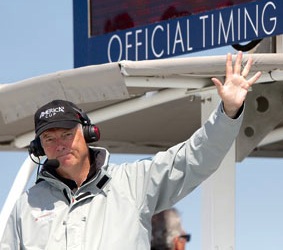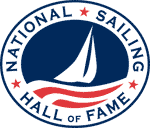By Gary Jobson
September 15, 2013
 When I arrived off the water this afternoon following two thrilling America's Cup races, my co-commentator, Ken Read, said, "Sailing will never be the same." The vision Larry Ellison and Russell Coutts had about high-speed catamarans racing up and down San Francisco Bay is now a reality. Sure, it got off to a slow start in July, but today was some of the most exciting racing I have witnessed as a competitor or spectator. We may never see a spectacle like this again, but right now the 34th America's Cup defense is proving to be sports theater at its best.
When I arrived off the water this afternoon following two thrilling America's Cup races, my co-commentator, Ken Read, said, "Sailing will never be the same." The vision Larry Ellison and Russell Coutts had about high-speed catamarans racing up and down San Francisco Bay is now a reality. Sure, it got off to a slow start in July, but today was some of the most exciting racing I have witnessed as a competitor or spectator. We may never see a spectacle like this again, but right now the 34th America's Cup defense is proving to be sports theater at its best.
The day started with the westerly breeze blowing in at 20 knots, with a swift current ebbing at 2.2 knots. There was a steep chop. At the start of Race Nine, Oracle Team USA, led by Australian skipper, James Spithill, clobbered Emirates Team New Zealand's skipper, Dean Barker. The Kiwis were three lengths behind at the first turning mark. Downwind the boats appeared to be even in speed. At the leeward gate, the boats split to opposite sides of the course. OTUSA's superstar tactician, Ben Ainslie, found the best current and wind to stretch their lead. At one point ETNZ was foiling upwind at 32 knots. They were able to do this by sailing a slightly lower course. But they gave away too much windward distance to gain any ground on the American team. The wind behaved and stayed just below the 20.8-knot wind limit. When Spithill and crew crossed the finish line, team owner Larry Ellison raised both arms in triumph. I think he was just as happy for this team as he was that his vision of the America's Cup was working.
Once again, there were huge crowds on the San Francisco waterfront, along with about 500 vessels of all sizes out on the bay. I call the race from the race committee boat, Regardless, while my colleagues, Todd Harris and Ken Read, work from shore. Today, I had the better seat. We were close to the action and you could see the subtle course changes and sailing techniques on these short 21-25 minute races. The courses are ten miles long. As an aside, I think they should include two more legs and be 40 minutes in length.
In Race Two, Spithill was slightly ahead and to windward at the start. Approaching the first turn OTUSA went off their foils for just one second, allowing ETNZ to hold on to a slim overlap. Barker took a very wide turn, forcing Spithill to wait to bear away on Leg Two. The move gave the Kiwis a four-length lead. Downwind nothing changed. At the leeward gate the two boats split tacks again. Back on the wind, the USA started gaining. They appeared to be a little faster. On the third cross, Barker had to dip behind Spithill, who was on starboard with the right of way. The very next cross saw the boats change leads again, when Spithill dipped below Barker. The race was riveting.
Approaching the windward gate, OTUSA was on starboard approaching the left gate. Barker slowed his boat down to cross behind Spithill, but rounded the right side gate. They were only one second apart. Ainslie called for OTUSA to sail down the city front, and New Zealand's tactician, Ray Davies, elected to sail out in the bay. When the boats converged it looked even. The Kiwis were on starboard. Spithill slowed down to give way. New Zealand took the lead and held on to the finish. The boats split wins for the day, and the score now stands 7-1. ETNZ needs two more wins to claim the America's Cup. OTUSA needs 8 more wins. It sounds daunting, but Spithill sounds very determined to turn the tide. The American design and shore crew have found ways to lighten the boat, move some weight around and make several small modifications. The changes have helped the USA level the playing field. We have seen ten starts now. By my scorecard Spithill and Barker have each won five.
With the boats so even, the premium on the start, good boat handling and clever tactics will likely be make the difference in the Cup. On television the boats look great, but in person they are even more impressive. The speed, size and power of these machines is inspiring. To paraphrase a Yogi Berra comment, “They are even better looking than they look."
On the leaderboard the American team is deep. But I think they can still win. Monday is a scheduled lay day. OTUSA gets better every time they go into the shed for modifications. New Zealand needs to be careful not to stay in one place. They have the luxury of making some experimental changes and if they loose two races they can easily go back to an earlier measurement configuration. One thing we have learned is that Spithill, Ainslie and their team are getting better, and will continue to improve.
Tuesday the wind is forecasted to be strong again. If we are able to race, OTUSA will be fast. However, I wonder if they have given away some of their light air speed to gain in a strong breeze? The measurers allow new certificates every day. OTUSA cannot afford to make any mistakes with their modifications or sailing. They can only afford to lose one more race. The Kiwis certainly like the score, but they are up against a very determined crew that looks like they are getting better every day. Just last week the American team lost ground on every tack. Now both boats are even when maneuvering.
Emirates Team New Zealand's syndicate head, Grant Dalton, sailed both races today. He was off the boat during the team's only two loses versus six wins when he was on-board. He did get his first loss today, but I think his presence was helpful in getting ready for the second heat, which they won.
A picture of the legendary Sir Peter Blake is on the wall of the entryway at the New Zealand team base. Sir Peter won around the world races, and led the New Zealand America's Cup team to victory in 1995 as a challenger, and in 2000 as a defender. Blake was killed by thieves in Brazil in 2001. Blake was known for wearing red socks as his good luck charm. In 1995 everyone in New Zealand was wearing red socks. Grant Dalton is one tough 56-year old who has won round the world races, and came close to winning the America's Cup in 2007. The Kiwis certainly gain inspiration from the memory of Peter Blake. Grant Dalton is working hard to honor his one time rival and friend. I doubt Dalton knows the story, but let's just say the team wants to win one for the Gipper. As for the America's Cup, it's hard to imagine what scenario could possibly top what we are watching? An American comeback maybe?





